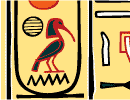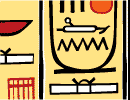The New York Times -- February 23, 1999
SCIENCE Q&A
The Mummy's Curse
 . Can you be cursed
for going into an ancient tomb?
. Can you be cursed
for going into an ancient tomb?
A. You can certainly be cursed at, by
archeologists. The history of ancient Egypt, for example, is
full of holes left by grave robbers, and remaining tombs are at risk from
tourism and development.
Egyptians believed tomb inscriptions could confer either blessings or
curses on visitors, and early visitors probably believed so, too, said Dr.
Peter Dorman, former director of Egypt House, the Oriental Institute
of Chicago archeological installation in Luxor, Egypt.
Tomb builders wanted to encourage passers-by to leave food for the dead
or just to recite a standard ritual wish for "bread, beer, cattle, and fowl,
which, merely through the spoken word, would magically generate those
commodities for the soul of the deceased," Dr. Dorman said.
By the year 2000 B.C., standard inscriptions included both praise and
blessings for those who recited the ritual and warnings cursing those who
might damage the tomb or its images, he continued. The warnings invoked
"condemnation and even outright slaughter at the hands of the gods of the
underworld," he said.
"This was not an idle threat," he said. "There was a clear understanding
that the dead could intervene in the lives of people on earth.
"It is ironic that so many tombs show intentional damage and that so few
burials in ancient Egypt have been found intact," he said.
C. CLAIBORNE RAY
Readers are invited to submit questions by postal mail to Questions,
Science Times, The New York Times, 229 West 43d Street, New York, N.Y.
10036-3959, or by E-mail to: Question@nytimes.com





